
|
Type of museum: General 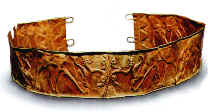 Golden Hair-Fillet, 4.5x5 cm (1.8x2 in) / 55 gr. Jafar-abad, Khalkhal, Azerbaijan, First millennium BC Decoration: Displays two opposite rows of rams flanking God Gilgamesh, executed in repousse with chased details. 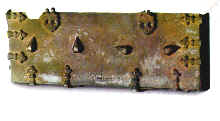 Metallic Combination Lock, 12x22 cm (4.8x8.8 in), Ajabshir (Azerbaijan) Craftsman: Mahmoud Isfahani, 1157 AD It has four cams, each capable of adopting one of 16 positions marked in Kufic characters in a circle. (65536 combinations of 4 digits)  Bronze Idol 12 cm (4.8 in), Lorestan, First Millennium BC It features a cylindrical double-sided anthropomorphic representation of God Gilgamesh flanked by two rampant beats attacking him. 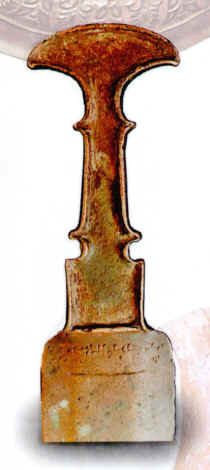 Bronze Sword Coppered color, Length:70 cm (28 in), Width: 5 cm (2 in) Maraqeh, Azerbaijan, 1007-1024 BC An inscription in two lines, Babylonian cuneiform script, adoms the junction of handle with blade: 1- From Simash Shipak (Shikho) 2- King of the World 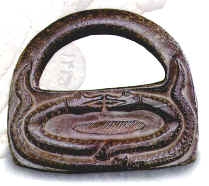 Sandstone Weight, Length: 27 cm (10.8 in), Width: 23.7 cm (9.5 in) 3rd Millennium BC Two entwined snakes with facing heads are on one side of the stone and on the other side four temples are engraved. 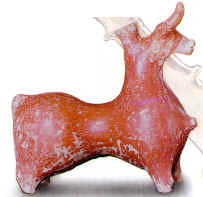 Ceramic Rhyton, Ocher Color, Length: 26 cm (10.4 in), Height: 27 cm (10.8 in) Mianeh, Azerbaijan, First Millennium BC This rhyton is in the shape of a hollow statue of homed bull and bears no design. 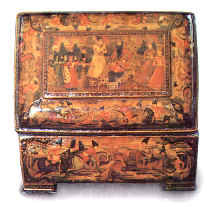 Lacquered Box Materials: Cardboard & wood, 19th century AD It is decorated with festive scene from Fath Ali Shah's Court (Qajar). 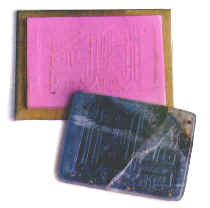 White Agate Seal Length: 5 cm (2 in), Height: 3 cm (1.2 in), 9th century AD It is engraved with an inscription in decorative Kufic script and bears the name of "Roknodoleh Hassan ebn Buyeh" below it. 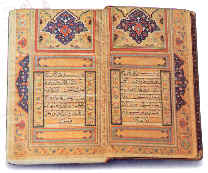 Quran L22.5x13.5 cm (9x5.4 in), Leathern book cover Fath Ali Shah Qajar period (1816) 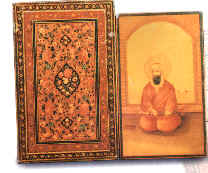 Lacquered Mirror-Case Materials: Cardboard & wood; 18th century AD It is decorated with miniature pattern of flowers, birds and butterflies. 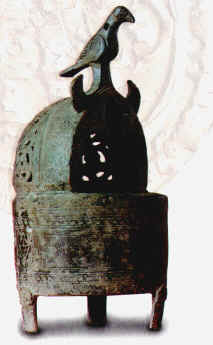 Bronze Incense Burner Height: 22 cm (8.8 in), Khorasan, 12th century AD Chased and open-worked with copper inlay. A bird statuette surmounts the altar-shaped top of the burner. 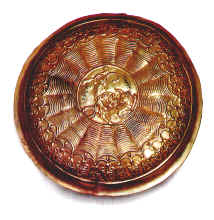 Lacquered Mirror-Case Diameter: 19 cm (7.6 in); Height: 3.2 cm (1.28 in) Talesh, Guilan; Achaemenian The center of bowl is decorated with medallion displaying lion attacking a bull, executed in repousse with chased details. These motifs are very frequent in Achaemenian art. 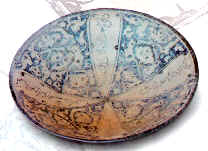 Ceramic Dish Diameter: 32.5 cm (13 in); Height: 9.2 cm (3.7 in) Kashan; 13th century AD Surface of dish is divided into for petals, painted in lapis lazuli color and enclosing a hemistich by Abu Said Abelkheir. 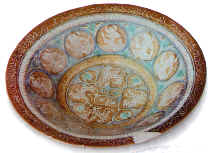 Lusterware Ceramic Dish Diameter: 34 cm (13.6 in); Height: 7.5 cm (3 in) Gorgan; 13th century AD Painted and glazed dish bearing a quatrain by Afzalodin Kashani, on its border. 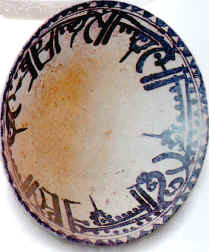 White Glazed Ceramic Bowl Diameter: 20 cm (8 in); Height: 7 cm (2.8 in) Neishabour, Khorasan; 10th century AD This painted and glazed bowl bears a frieze in Kufic script. 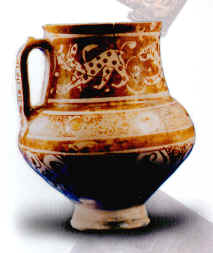 Ceramic Pitcher Diameter: 9.5 cm (3.8 in); Height: 16.5 cm (6.6 in) Gorgan; 13th century AD Golden paintings of 3 animals cover the white background of the pitcher and Arabesque designs are visible on its lower part. 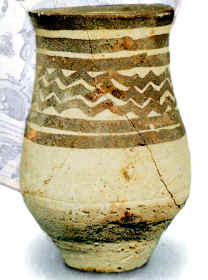 Ceramic Pitcher Upper Diameter: 6 cm (2.4 in); Height: 12 cm (4.8 in); Buff-colored Shahr Sukhteh (SYstan & Baluchistan); 4th millennium BC Black geometric patterns cover the vessel's neck and the upper part. 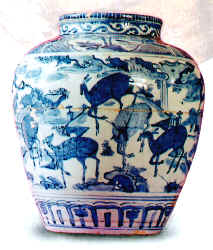 Ceramic Jar Diameter: 17 cm (6.8 in); Height: 36 cm (14.4 in) Ardebil, Azerbaijan; Safavid (Shah Abbas, 16th century AD) Natural landscapes lncluding trees and deer are painted on it, which also bears the Seal of Shah Abbas. 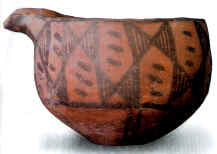 Ceramic Bowl Upper diameter: 11.5 cm (4.6 in); Height: 9.5 cm (3.8 in) Ismail-abad, Karaj; 5th millennium BC It has a gutter beak on its edge and a row of pared triangular patterns surrounds its body. 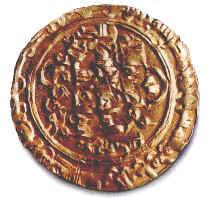 Gold Coin Diameter: 2.4 cm (1 in); Weight: 4.6 gr. Minting place: Ahvaz, 1110 AD Soltan Mahmoud Qaznavi period 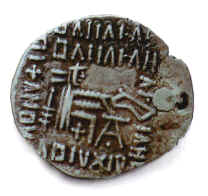 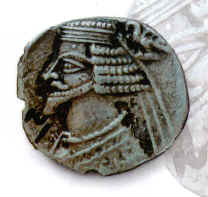 Silver Coins Diameter: 2 cm (.8 in), Weight: 3.6 gr. Parthian era It bears an engraving Farhad (!4th Ashk) and that of an archer holding a bow. In its margin, the names Basileus, Arshakus, Ikayus, Epiphans and Philhellenus are inscribed. 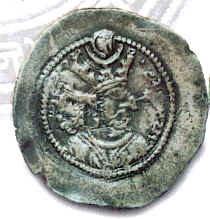 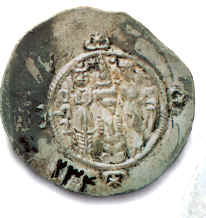 Silver Coins Diameter: 3.3 cm (1.3 in); Weight: 4.12 gr. Sassanid Monarch The recto bears on effigy of Yazdgerd III and the verso displays a holly brazier flanked by 2 soldiers, standing, sword in hand.  Silver Coin Weight: 2.9 gr. Omavian Period (Hashem ebn Abdolmalek, 695 AD) Minte in Vaset, a city in Iraq 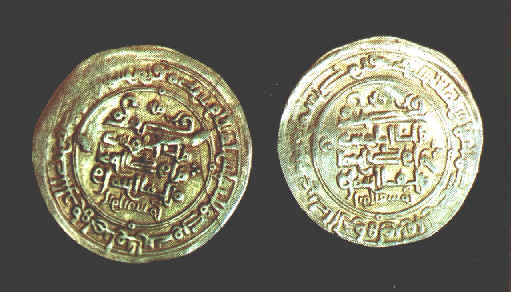 Coins After Sassanid Monarch 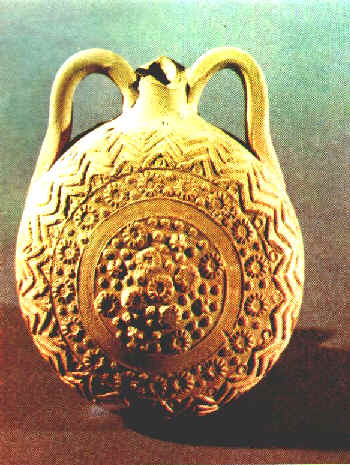 Buff-colored Ceramic Jug 1st millennium B.C.; Arsacid Relief Decorative Patterns
|
© Copyright Caroun.com. All rights reserved.